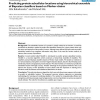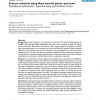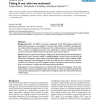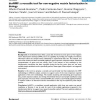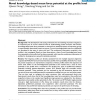BMCBI
2006
13 years 11 months ago
2006
Background: In class prediction problems using microarray data, gene selection is essential to improve the prediction accuracy and to identify potential marker genes for a disease...
BMCBI
2006
13 years 11 months ago
2006
Background: The subcellular location of a protein is closely related to its function. It would be worthwhile to develop a method to predict the subcellular location for a given pr...
BMCBI
2006
13 years 11 months ago
2006
Background: Common fragile sites (cfs) are specific regions in the human genome that are particularly prone to genomic instability under conditions of replicative stress. Several ...
BMCBI
2006
13 years 11 months ago
2006
Background: Feature selection is an approach to overcome the 'curse of dimensionality' in complex researches like disease classification using microarrays. Statistical m...
BMCBI
2006
13 years 11 months ago
2006
Background: REX1 and REX2 are protein components of the RNA editing complex (the editosome) and function as exouridylylases. The exact roles of REX1 and REX2 in the editosome are ...
BMCBI
2006
13 years 11 months ago
2006
Background: One of the important goals of microarray research is the identification of genes whose expression is considerably higher or lower in some tissues than in others. We wo...
BMCBI
2006
13 years 11 months ago
2006
Background: In the Bioinformatics field, a great deal of interest has been given to Non-negative matrix factorization technique (NMF), due to its capability of providing new insig...
BMCBI
2006
13 years 11 months ago
2006
Background: The aim of protein design is to predict amino-acid sequences compatible with a given target structure. Traditionally envisioned as a purely thermodynamic question, thi...
BMCBI
2006
13 years 11 months ago
2006
Background: Direct synthesis of genes is rapidly becoming the most efficient way to make functional genetic constructs and enables applications such as codon optimization, RNAi re...
BMCBI
2006
13 years 11 months ago
2006
Background: The development and testing of functions for the modeling of protein energetics is an important part of current research aimed at understanding protein structure and f...

